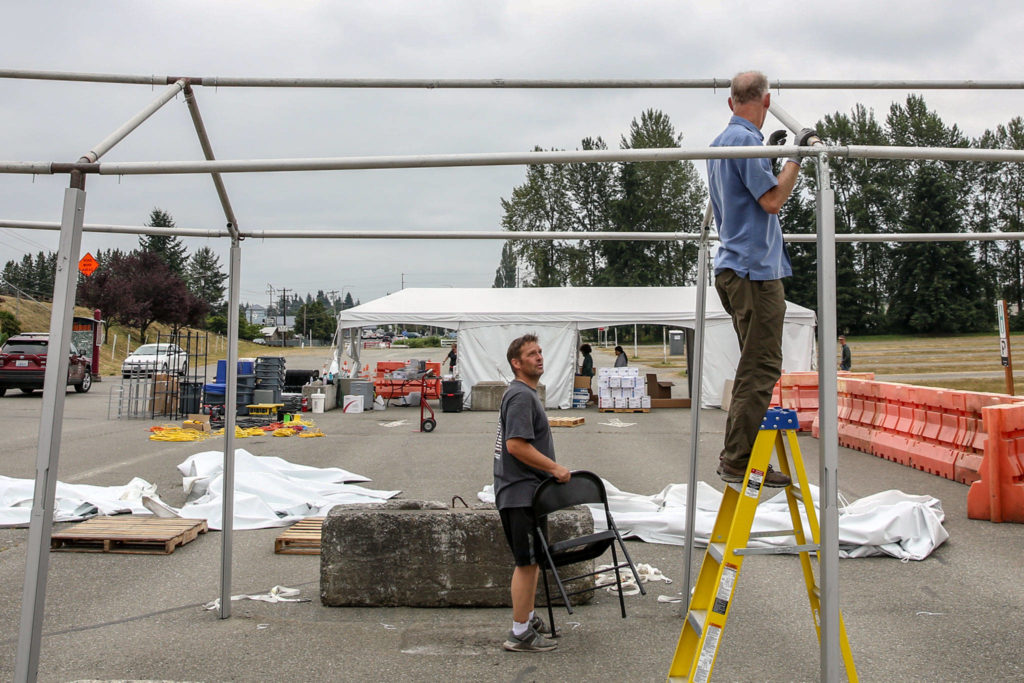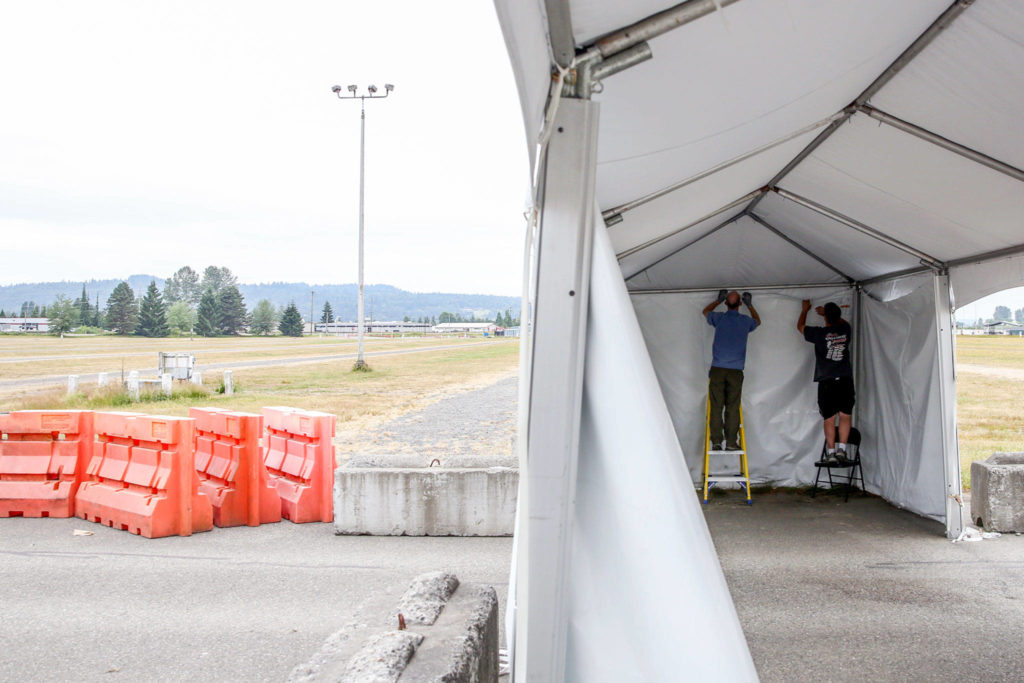EVERETT — For the past 500-plus days, a large room in a south Everett office building has been ground zero for the decisions that shaped the pandemic response in Snohomish County.
Inside, 199 people from 18 public agencies and private nonprofits — including the Snohomish Health District, emergency management, the Snohomish County Sheriff’s Office, human services, fire departments and city governments — worked together on the problems, big and small, presented by COVID-19.
Their assignments ranged from organizing vaccine clinics, to setting up a 96-bed field hospital, to acquiring 22 million pieces of personal protective equipment in the midst of a nationwide supply shortage, to connecting families in need with fresh produce from local farmers.
“It’s amazing people who do amazing work,” Snohomish County Emergency Management Director Jason Biermann said in a late June interview. “I’m proud of this team.”
Those efforts are now winding down.
On Friday, the county deactivated its Emergency Coordination Center as Snohomish County, the state and many parts of the country emerge from the pandemic. Most members of the teams that filled the center each day are back to their previous responsibilities around the county.
However, the coronavirus isn’t going away, Biermann said. A select few will remain in the center to maintain what’s left of the county’s response and plan for what’s next.
A bittersweet ending
On an overcast Wednesday in June, members of the county’s emergency response team arrived at 8 a.m. to tear down the mass vaccination clinic at the Evergreen State Fairgrounds in Monroe.
Months prior, thousands were visiting the site each day to get their first or second shots of the Moderna vaccine.
The Ash Way Park and Ride clinic is the only mass site that remains, as nearly two-thirds of county adults have received at least one dose. In total, the county’s seven clinics administered about 320,000 shots.
Janette Anderson, a South County Fire paramedic, was at the Monroe clinic nearly every day it operated after opening in February.
Now, it’s bittersweet to leave, she said, as the tents, traffic cones and folding chairs were hauled away for storage.
“It was like a family,” Anderson said. “I wish we could have everybody back for a barbecue or something to celebrate, and see how everything is now.”
In total, some 1,700 county employees, first-responders and volunteers worked at the mass vaccination sites.
Many of them say the best part of the work was seeing people’s reactions when they finally received the potentially life-saving shot.
“It was like they won the lottery to get here,” Anderson said.
Some sang or danced. Others cried.
“You kind of choked up with them,” said Leslie Buck, a longtime member of the county’s Medical Reserve Corps. “It was an incredible moment. A lot of us had been waiting a lot of time for these vaccines to come through, and they were very difficult to get.”
Buck, a retired nurse, joined the volunteer corps in 2014. She volunteered three to four days each week during the pandemic.
“Anybody that volunteers on a regular basis, we do it because we love volunteering,” she said. “We want to give back to the community.”
Her first assignment was at the testing site at Funko Field in Everett, she said.
Since then, she has answered phones at the county’s COVID call center, served as a contact tracer and worked at all of the county’s mass vaccination sites. Now she’s a site manager for mobile vaccine clinics.
“What haven’t I done?” she said. “I think I filled every single role there was over the last year and a half.”
Throughout the pandemic, there were 300 to 500 regular volunteers with the corps, Director Therese Quinn said — so many that some were sent to help in Skagit, Whatcom and Island counties.
Now fewer first responders and volunteers are needed on the front lines of the pandemic, though Buck and Anderson are both still serving at mobile vaccine clinics.
And the reserve corps is continuing to help with COVID test sites and hospital screenings, Quinn said.
We’re not done, yet
Despite most COVID-19 restrictions being lifted statewide, public health experts are adamant that the pandemic isn’t over — especially for the unvaccinated.
“We’ve made a lot of progress,” Snohomish Health District health officer Dr. Chris Spitters said Tuesday. “However, we are still seeing new cases and outbreaks throughout the county.”
The latest two-week case rate shows 80 new infections per 100,000 residents. Last week it was 70 per 100,000.
Those figures don’t amount to the peaks of previous waves, and vaccines are providing robust protection to more than half of the county.
However, more-infectious COVID variants are taking root in Snohomish County, and those without shots are at heightened risk.
While we don’t know the magnitude, there will be a fifth wave of infections.
The best way to be protected, Spitters said, is to get vaccinated.
Countywide, there are still about 200,000 adults who haven’t received a shot.
On Friday, Gov. Jay Inslee stood beside Kameron M. of King County, the $1 million winner of the state’s vaccine lottery, pleading with Washingtonians to get their shots.
“He thought getting a vaccine was the right thing to do,” Inslee said. “And we thank him for that … If you’re not vaccinated right now, you’ve got a target on your back.”
The “Shot of a Lifetime” campaign offered big cash prizes and more in the name of convincing people on the fence about vaccines.
Local leaders are shifting their focus to using targeted mobile clinics to reach communities that have so far passed on getting vaccinated.
Additionally, health officials are leaning on primary care doctors to explain the benefits of the shots to unvaccinated patients.
The shift to recovery
Back in the Emergency Coordination Center, some emergency management staff will stick around as the department focuses on reimbursement for pandemic-related expenses, maintaining the remaining vaccination site at Ash Way in Lynnwood and overseeing the nourishing neighborhoods program.
They’re also ensuring they can spring back into action in case of a spike in COVID activity.
Meanwhile, others are back to preparing for the next emergencies to hit the county: wildfires, smoky air, floods or possibly an earthquake.
Eventually, the long-term pandemic recovery effort will transition to Snohomish County Executive Dave Somers’ office, which is in the early stages of forming an Office of Recovery.
On Wednesday, Somers submitted to the Snohomish County Council his plan for spending $79.8 million from the American Rescue Plan Act on economic and public health programs.
His proposal includes $27 million for community health programs aimed at substance abuse, food security and housing assistance; another $28 million for business support, workforce recovery and tourism; and $22 million for county services and other projects, including the Office of Recovery.
“We know that workers and businesses have struggled. Rates of substance abuse and mental health crises have spiked. Many families are concerned about keeping their home and putting food on the table,” Somers said in a news release. “Our Snohomish County Recovers plan will address these and other critical issues.”
The proposal accounts for about half of the county’s $160 million of federal relief money. The remaining dollars will be available for use in 2022.
Joey Thompson: 425-339-3449; jthompson@heraldnet.com. Twitter: @byjoeythompson.
Talk to us
> Give us your news tips.
> Send us a letter to the editor.
> More Herald contact information.



























